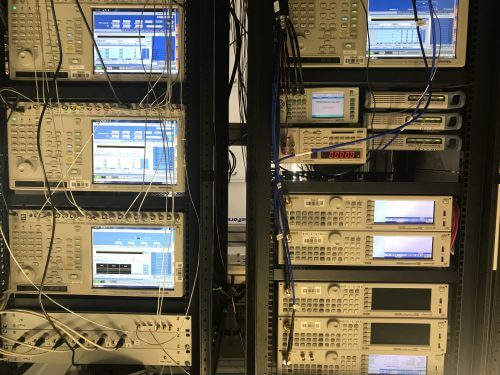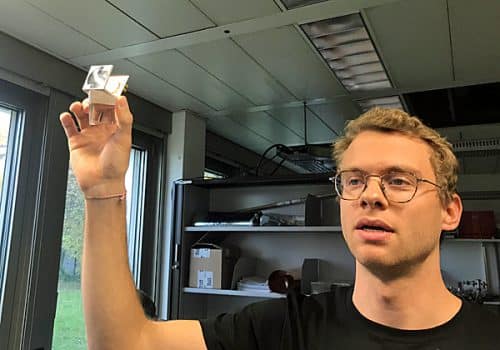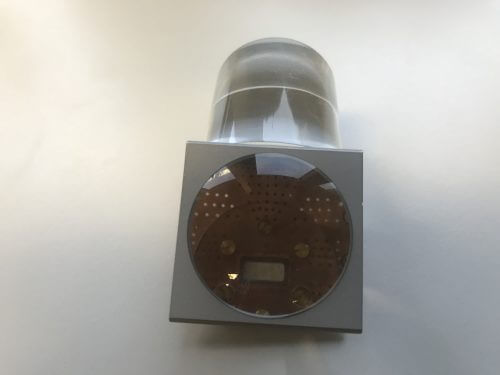And also why it is worthwhile to develop today an encryption that will be immune to cracking by quantum computers. Recorded a tour of the IBM research center in Zurich

IBM's two-qubit quantum chip, at the research center in Zurich. Photo: Avi Blizovsky
There is still a need to explore all the methods for quantum computation, and to improve the error correction system before a universal quantum computer can be built. This is what Dr. Stephan Philipp, head of the Quantum Research Laboratory at IBM's development center in Zurich, says at a meeting of journalists who came to Zurich from all over Europe
Today, too, it is possible to perform quantum machine learning calculations, protein folding, chemical search and optimization of an investment portfolio, pricing and risk management, dynamic inventory management, and more on the quantum computer with a processing capacity of up to 20 qubits in Yorktown, New York.
IBM participates in the Qiskit open source project - designed to leverage today's quantum processors and conduct research. According to Philip, the field of quantum computing can be of interest not only to quantum physics scientists, but to scientists in all fields, teachers, developers and technology seekers in general, who can write code in quantum machine language, build algorithms and applications, detect noise and errors and accelerate computing using simulators and debuggers - each of these fields is A sub-project in itself. The first two areas are already operational and the others will be operational in the near future.
Philip also introduced the IBM Q network established in December 2017, a partnership with leading Fortune 500 companies, universities and research institutes around the world. "The goal is to accelerate research through collaboration with universities and research institutes to advance quantum computing technology, to encourage industry leaders to combine IBM quantum computing experts with people who are experts in a specific field to develop the first commercial applications that will set an example. In addition, the project also has an educational goal - to expand and train the ecosystem of users, developers and application experts who will eventually be able to adopt the quantum computer on a large scale."

"In the age of the quantum computer, Bitcoin will be hacked if not transferred to a secure algorithm"
"If not transferred to a crack-proof algorithm in a quantum computer, the cryptographic component of Bitcoin will be cracked in 2026," warned Dr. Vadim Lubashevsky, a cryptography researcher at IBM's research center in Zurich. Dr. Lubshavsky said these things during a press conference held at the center a few days ago.
According to him, "If the technology behind Bitcoin falls into the wrong hands, the systems that control the movement of money will no longer be safe. It will be possible to intercept transfers and empty accounts."
He added that "the smaller the encryption key, the faster the data will be exposed. Bitcoin's key size is such that it may break in 2026. Therefore, it is necessary to use a new type of mathematics - a kind of insurance against the damages of the quantum computers. You just have to find another algorithm than the one that decomposes into factors. A quantum computer is not needed to develop such algorithms."
Lobszewski said that the creators of the virtual currency, as well as creators of information in general, who require long-term encryption, should transfer their products to secure algorithms already today, even before this era begins. According to him, "The reason for the strength of the quantum computer is that, while a billion transistors are required to multiply the power of a classical computer a billion times, to multiply the power of a quantum computer a billion times, 30 qubits are enough. This is because the growth rate of calculation capacity in a quantum computer is exponential."
"It is true that not every problem will be solved a billion times faster using a 30 qubit quantum computer, but the main problem that it will be able to solve will be the problem of encryption with public and private keys," Lubshavsky said.
He also noted that "no one knows when a universal quantum computer will be built, but many estimate that it will happen and are investing a lot of money in it, including IBM." Be that as it may, he said, “Now, when quantum computers are still relatively weak, we have a window of time to introduce a new cryptography, immune to cracking in these computers. New encryption needs to be used together with existing encryption, and next year IBM will present several such systems at its quantum computing conference."
Lubshavsky concluded by saying that "many submitted proposals for standards in the field and it is estimated that by 2023 several standards will be developed, but my advice is not to wait and act now, because most of the proposals are similar anyway and in any case, it would be worthwhile to use the new encryption methods together with the existing ones."

A tour of IBM's quantum computing center in Zurich
Later, Matthias Mergenthaler, a postdoctoral student at the IBM research laboratory in Zurich, gave the journalists a tour of the facility, where a modest quantum computer is located - which contains only two qubits. The first thing you see on the tour is two huge cooling tanks, which each cool one quantum chip to a temperature very close to absolute zero - less than half a degree above it. Around these containers are boxes with keyboards and optical fibers, which connect them to the processor inside the refrigerator using low-power microwave radiation. This, to perform the calculation without causing the quantum computer to heat up.
The really powerful quantum computers of the blue giant are located in Yorktown in the state of New York, United States. Their little brother in Zurich was designed for one task: to test new architectures for quantum chips - which are being built in another building on the same campus.
Although it's an impressive computer, IBM's European quantum computer still can't crack ciphers yet. Experts estimate that thousands if not millions of qubits would be required to accomplish the task. Fortunately, IBM scientists have already developed quantum computing-proof cryptography that can prevent the scenario from playing out, and it's already available today.
This explains why the computer is located in Zurich, one of the largest banking centers close to clients such as Barclays and JP Morgan who are beginning to try IBM's quantum computing technology.

5 תגובות
Nati, just because you don't understand doesn't mean it's not true. In any case, you need to study quite a bit to understand it reasonably. Take a course in quantum theory, a course in quantum computation and then ask. Nissim was just trying to help. You don't really expect an explanation in response to the article that will explain it right?
Thanks Nissim. You just proved (again) that no one really explains how you can use superposition to perform a calculation
In a way that can be understood...
But thanks for the answer to the fragment of the question.
Nati
I can give you two examples of random processes that provide a deterministic outcome.
The first is a way to calculate pi. The idea is to draw pairs of numbers between 0 and 1, and calculate the sum of their squares. Calculate the percentage of these values that are less than 1. This percentage is relative to pi divided by 4.
The second example is an efficient way to sort numbers. Choose one of the numbers at random and sort the rest of the numbers into two groups: those that are smaller and those that are larger. Perform the same process on each of the groups, and continue until the groups become of one member.
I am not saying that this is how a quantum computer works, but I have shown that a random process can indeed have a deterministic value.
Waiting for someone to explain how a non-deterministic process like superposition and wave collapse can provide a basis for a deterministic calculation.
Can't find anyone on the internet who can really explain it simply.
And now the truth about Bitcoin and quantum computers:
https://www.bitcoin.org.il/%D7%9E%D7%97%D7%A9%D7%95%D7%91-%D7%A7%D7%95%D7%95%D7%90%D7%A0%D7%98%D7%99-%D7%95%D7%9B%D7%99%D7%A6%D7%93-%D7%94%D7%95%D7%90-%D7%9E%D7%A9%D7%A4%D7%99%D7%A2-%D7%A2%D7%9C-%D7%91%D7%99%D7%98%D7%A7%D7%95/